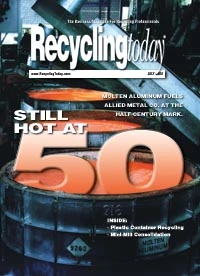Even with some recent developments in plastic container recycling that would seem positive, some are still skeptical about the state of plastic container recycling.
Dr. James Burke of SP Newsprint, Atlanta, told attendees of the 2002 Paper Recycling Conference & Trade Show, which took place in late June in New Orleans, that many in the paper industry believe the plastic industry has not done its share to support recycling.
In a 20-year span, U.S. newsprint mills have more than tripled their annual consumption of scrap paper—from 1.5 million tons in 1980 to 6.5 million tons in 2000. “This required hundreds of millions of dollars of capital investments,” Burke remarked of the changeover in production from virgin to secondary commodities.
As a result, the paper industry is now a major consumer of scrap paper and a buyer of massive amounts of materials collected through curbside programs. On the collections end, Burke said there is also a feeling that the paper industry (along with the aluminum industry) is carrying the weight of the recycling industry. “Beverage containers—except for aluminum cans—are not recyclable,” Burke said in regard to the less established plastic market and the struggling glass market. “Plastic bottles and tin cans don’t really carry their own weight. I’m tired of carrying recycling programs.”
Burke also said that environmental regulators are concerned about the presence of polymer “floaters” in the effluent streams of paper mills that are pulping scrap paper contaminated with plastic. “If we can’t get a clean product, we’ll have to adjust our mills to use more wood.”
Another conference presenter, Harvey Gershman of consulting firm GBB Inc., Fairfax, Va., says his firm has at times advised communities to omit glass and plastic from curbside collection programs, in part to focus on paper grades that can be free of contaminants.
But other recyclers in attendance defended the state of plastics recycling. Steve Ragiel, vice president of recycling for Waste Management Inc., Houston, says plastic containers, “can be strong contributors to residential recycling programs.” Waste Management operates as many high-volume MRFs as any company in North America, and will remain committed to the single-stream collection and processing of several commodities, including PET and HDPE containers, according to Ragiel.
Like some other recyclers interviewed, a West Coast recycler who spoke to Recycling Today noted that trading in the plastic market can be frustrating. “The price jumps up and down with the fuel price. Sometimes you cannot bale it and process it for what it is worth at the export pier.”
But improved sorting technology—which could help fulfill emerging demand in the soda bottle market—could be the key to the future. “The process by which we handle plastic changes; it’s evolving fast,” says the West Coast recycler.
Sponsored Content
Labor that Works
With 25 years of experience, Leadpoint delivers cost-effective workforce solutions tailored to your needs. We handle the recruiting, hiring, training, and onboarding to deliver stable, productive, and safety-focused teams. Our commitment to safety and quality ensures peace of mind with a reliable workforce that helps you achieve your goals.
Waste Management’s Ragiel credited equipment makers for continued advances. “Vendors of equipment have upgraded the quality. They are on their fifth or sixth generation of machines, and the quality now is head and shoulders above what we were seeing even 18 months ago,” says Ragiel.
In short, recyclers are ready to stay in the plastics game. As the West Coast recycler put it, “As an industry, we need to handle this product. It’s growing as a packaging product, so we need to learn how to process it and market it.”

Explore the July 2002 Issue
Check out more from this issue and find your next story to read.
Latest from Recycling Today
- Steel Dynamics cites favorable conditions in Q1
- Hydro starts up construction in Spain
- Green Cubes unveils forklift battery line
- Rebar association points to trade turmoil
- LumiCup offers single-use plastic alternative
- European project yields recycled-content ABS
- ICM to host colocated events in Shanghai
- Astera runs into NIMBY concerns in Colorado







